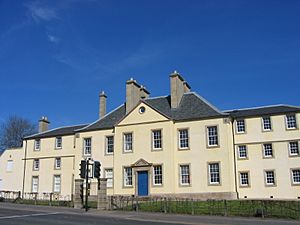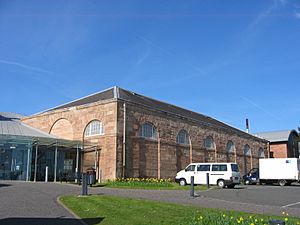Hamilton Low Parks Museum facts for kids

Low Parks Museum, Portland Building
|
|
| Lua error in Module:Location_map at line 420: attempt to index field 'wikibase' (a nil value). | |
| Established | 1967 |
|---|---|
| Location | Hamilton, South Lanarkshire |
| Type | Regimental museum |
The Low Parks Museum is a cool place in Hamilton, South Lanarkshire, Scotland. It helps you explore the history of South Lanarkshire. The museum shows off many interesting exhibits about local industries and important events from the past.
Discovering the Museum's History
The Low Parks Museum first opened its doors on November 3, 1967. Back then, it was called the Hamilton District Museum. It is housed in two old buildings that are very important to Hamilton's history. These buildings are right next to where Hamilton Palace used to stand. The palace was taken down in 1927.
One of the museum's buildings is called Portland. It was built way back in 1696 by an architect named James Smith. It was first the home of David Crawford, who worked for Anne Hamilton, 3rd Duchess of Hamilton. Many people believe it is the oldest building still standing in Hamilton. Later, it became a busy inn for travelers. In 1835, it turned into offices for the Duke of Hamilton's estate. Finally, in 1964, the Hamilton Burgh Council bought it and made it into the museum we see today.
The second building is the old Palace Riding School. It was built in 1837 for Alexander Hamilton, 10th Duke of Hamilton. This building became the museum for the Cameronians (Scottish Rifles) in 1983. In 1993, new parts were added to connect the two buildings. This created one big museum with a new entrance. Both buildings are very important and are listed as "category A" buildings.
Explore the Museum's Exhibits
The Cameronians: A Scottish Regiment
A big part of the museum is dedicated to the Cameronians (Scottish Rifles). This was a famous British Army regiment. The Cameronians were formed on May 14, 1689. They were named after Richard Cameron, a Scottish preacher. What makes them special is that they were the only British military regiment with a religious beginning. Their first soldiers were all Covenanters.
In 1881, two regiments joined together to form the Cameronians (Scottish Rifles). They were the only rifle regiment in Scotland. They fought in many battles over almost 300 years. The regiment was very important to South Lanarkshire's history. It was based in the county for most of its time. Sadly, due to military cuts, the regiment was disbanded on May 14, 1968. This ended 279 years of military history.
The museum's Cameronians collection shows many items from the regiment's past. You can see their flags and banners, like the Bluidy Banner. This flag was carried by Covenanter forces in 1679. The museum also has over 1,000 medals and awards. These include seven Victoria Crosses, which are very brave awards.
Hamilton Palace: A Lost Treasure
One of the most popular displays tells the story of Hamilton Palace. This palace was the main home of the Hamilton family for hundreds of years. It was the biggest non-royal house in Britain! But because of a decline in coal mining, the palace was torn down in the 1920s. This was a huge loss for Scotland's history. The museum has many items from inside the palace, like a giant mirror. You can also see old pictures of the palace before it was demolished in 1927.
Coal Mining: A Key Industry
Another exhibit explores coal mining. Before the late 1800s, coal mining wasn't a huge industry in Hamilton. But after a mining boom in 1874, it grew very quickly. There were 22 coal mines in the Hamilton area alone! The museum's display shows what this time was like. It also has a small exhibit about the Blantyre Mining Disaster of 1877. In this tragic event, 207 miners lost their lives in an explosion. It remains Scotland's worst mining disaster.
Agriculture: Farming Life
Before factories became common, most people in South Lanarkshire worked in agriculture. The museum's farming display focuses on a famous farm animal: the Clydesdale Horse. These large, strong horses were very important for farm work.
Weaving: Threads of History
Weaving was a very important industry in Lanarkshire's past. Almost every home had a weaving loom. You can see one of these original looms in the museum's Textile gallery. This gallery also shares the story of Hamilton's special lacemaking industry. Duchess Elizabeth started this craft in 1752.
Ducal Buildings: Grand Structures
This section shares information about the grand buildings built by the Dukes of Hamilton that are still standing. This includes the Portland building and the Palace Riding School, which are part of the museum. It also covers the Hamilton Mausoleum. The exhibit tells the stories of these important buildings and the people who built and used them.
Early Settlers in South Lanarkshire
One of the most amazing items in the museum is a 4,000-year-old Bronze Age burial. This well-preserved skeleton was found in the 1930s. It shows us one of the very first people who lived in South Lanarkshire.
Past Special Exhibitions
The museum often hosts temporary exhibitions. For example, in 2013, there was a robot exhibition. It featured famous robots from movies and TV, like R2-D2 from Star Wars and a full-size RoboCop costume. The museum also shows art from local groups. It regularly has demonstrations of old costumes and weapons. Visitors can even try activities like archery and making medieval coins.
The museum has also brought history to life with actors playing Duchess Anne and Alexander Hamilton, 10th Duke of Hamilton. This show, called ‘At Home with the Duke and Duchess’, gave a peek into the lives of these important figures from Hamilton’s past.
See also
- List of Category A listed buildings in South Lanarkshire
- List of listed buildings in Hamilton, South Lanarkshire
- List of museums in Scotland



